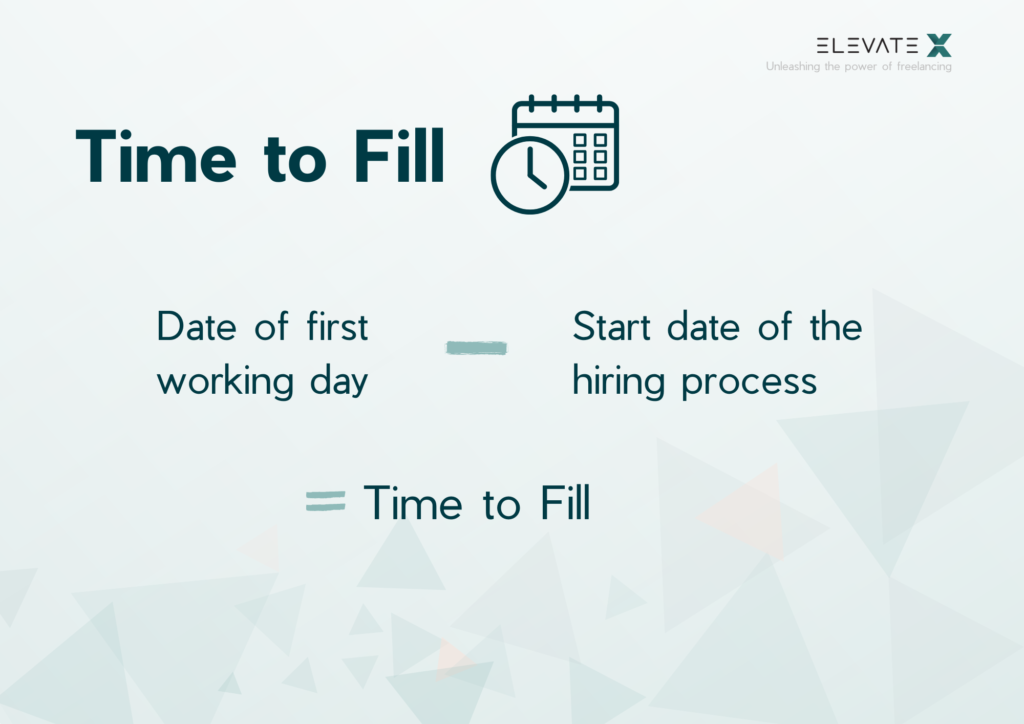Time to Fill is a significant metric for recruiting. It provides you with a simple reference point for evaluating hiring processes. It enables the determination and control of hiring and recruitment costs. Regularly reviewing this metric during the filling of vacancies provides crucial information for future business decisions. This could relate to the efficiency of internal workflows or external factors such as the current development of the job market. In this article, you will learn everything you need to know about Time to Fill and what the time until a position is filled means for your workflows.
What is Time to Fill?
The English term Time to Fill refers to the period required to fill a position. It is measured in days. The start date can be the approval of a position filling in the company. An alternative is the publication date of the job advertisement. The date of the first working day marks the end of the Time to Fill.
Besides Time to Fill, the terms “duration of filling” or “vacancy time” are common. Time to Fill is one of the most important metrics in recruiting. It measures the efficiency of the hiring process in a company. There is no exact guideline for the calculation, as companies set the beginning of the period differently. In smaller companies, it is often more sensible to start with the publication of the job advertisement. In larger ones, the internal requirement report is usually taken.
KEY POINTS
Time to Fill measures the duration from job posting to placement, thereby assessing the efficiency of the recruiting process.
Time to Hire focuses on the time span from job advertisement to contract signing, reflecting the speed of candidate selection.
By using freelancers, companies can effectively reduce costs and productivity losses for unfilled positions.
How is Time to Fill Calculated?
You can calculate the duration of filling with a simple formula. Subtract the start date from the date of the first working day:
Date of first working day – Start date of the hiring process = Time to Fill
You can calculate the time span for a short hiring process in your head. For longer periods, the comparison of different processes, or large amounts of data, it is best to use professional software.

Which Factors Affect Time to Fill?
How a hiring process looks depends on the industry, the type of position, and the workflows in a company. Typically, the following steps play a role:
- Vacancy of a position or creation of a new position and notification to HR
- Review or creation of the job profile
- Budget planning
- Reporting the vacancy to the employment agency
- Publication of the job advertisement on the internet, in print media, and other channels
- Resume screening
- Interviews and aptitude tests
- Selection of top candidates
- Making the job offer and contract negotiations
- Contract signing
- Waiting time until the start of work
How Long Can Time to Fill Be?
Average times for Time to Fill vary from industry to industry. In the sales and customer service sector, they are shorter than in research or financial services. When evaluating the periods, it is also important to consider the peculiarities of the respective position. For executives, skilled workers with special knowledge, or IT positions with extensive responsibilities, the process takes significantly longer.
To determine whether the recruiting process in the company is carried out efficiently, it is advisable to collect several values. A comparison of vacancy times and their average value allows more precise conclusions than a single process.
If a detailed analysis of the metrics reveals that the period is regularly too long, the recruitment process needs to be optimized. Promising measures include:
Improved Job Advertisements
The ads must be attractively and understandably formulated. It is important to publish them in various places and media to reach enough interested parties.
Personnel Service Providers
Personnel service providers save time and costs by suggesting qualified candidates to companies.
Simplifying the Recruiting Process
Complicated processes should be restructured. This allows for faster and more flexible execution.
Improving Communication
Simplified communication channels, digitalization, and special application management tools save time.
Internal Recruitment and Talent Pools
Both methods can shorten the pre-selection and lead to a quick filling of positions.
Discover How Freelancers Can Reduce Your Time to Fill!
What is the Difference Between Time to Fill and Time to Hire?
Another important metric for the efficiency of the hiring process is Time to Hire. It refers to the time span between the job posting and the signing of the employment contract. Thus, it represents a subset of Time to Fill.
Time to Hire reveals whether the processing of application documents and the selection of suitable candidates are proceeding swiftly. This is important for several reasons. On the one hand, this process should also be efficient and not cause unnecessary costs. On the other hand, there is a risk that good candidates may drop out if the company takes too long to respond.
Lastly, a long Time to Hire can negatively impact the company’s reputation. Frustrated applicants exchange information among themselves. If it becomes known that a company does not respond promptly to applications, this especially deters highly qualified prospects. This results in the company losing expertise and potential.
Occasionally, the term Time to Hire refers to the period from the receipt of an application by the company to the signing of the contract. This can measure how long applicants have to wait for a decision.
How Freelancers Reduce Costs During Vacancies
Unfilled positions incur costs. These are the direct costs incurred by filling the position: posting and managing job ads, processing applications, conducting interviews. These costs increase with the duration of the vacancy.
Additionally, there are indirect costs resulting from no productive work being done on the unfilled position. These opportunity costs are often difficult to quantify. They manifest in lost sales or reduced production performance. This reduces the company’s competitiveness. Also, a lack of qualified personnel negatively affects service quality and thus customer satisfaction.
With ElevateX’s cost of vacancy calculator, you can calculate these costs and get an overview of how the unfilled position is likely to impact the company’s figures.
Competent freelancers represent an efficient way to lower these costs until you have filled a position. They have the know-how and experience that is available to your company during the vacancy. This increases production performance and competitiveness. Additionally, freelancers relieve the other team members.
If you are looking for a freelancer for your company, you can make a non-binding inquiry at ElevateX.
Conclusion - Optimize Time to Fill and Reduce Vacancy Costs
Whether you want to fill a newly created position or a vacancy that has arisen, it’s important to keep Time to Fill as low as possible. You can do this by optimizing workflows in the company and searching for new workers in a time-efficient manner.
However, not all factors are controllable. Sometimes filling a position takes longer than planned due to the labor market situation. Then it’s important to keep the resulting vacancy costs as low as possible.
Time to Fill is the number of days between the start of a position filling and the first working day. It represents an important, meaningful performance metric for a company’s recruitment process.
The formula is:
Date of first working day – Start date of the hiring process = Time to Fill
The start date can be the internal requirement report or the publication of a job advertisement.
An optimized recruiting process is crucial for the shortest possible time until successful position filling. During a vacancy, freelancers have proven effective in minimizing unwanted cost effects.








